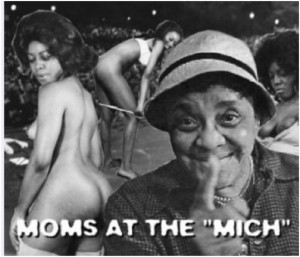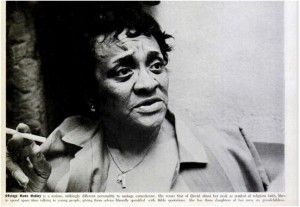Moms at the myth (Part 1)
30 October 2014 – Mary Rizzo

Moms at the ‘Mich’: Cover of the mysterious “lost” Moms Mabley album. Photo credit: Rateyourmusic.com
There are layers of history contained in the album cover for Moms at the “Mich.” Jackie “Moms” Mabley’s career ran from the queer Harlem comedy clubs of the 1920s to early race films, from the mid-century “chitlin’ circuit” to the family-friendly late-career movie Amazing Grace (1974). But this… this is a doozy, closer to the porn-comedy LPs of Blowfly than the lyrics of earlier lesbian entertainer Gladys Bentley.
We were led to Moms at the “Mich” last year by an innocuous comment on Moms Mabley’s Wikipedia page: “She appeared in movies, on television, and in clubs, and performed at the Michigan Women’s [sic] Festival shortly before her death in 1975,” it read. We were reading the page out of a shared interest in Mabley’s fascinating life and career: Strub was teaching a class on film and urban history that covered 1930s race films, Rizzo was working on a cultural history of Baltimore, where Amazing Grace was set (though mostly not shot). We’re both interested in women’s and feminist history, and seeing that statement set bells off. A little Googling later, Moms at the “Mich” washed up into the browser.
Even at a glance, this story clearly challenged some dominant historical narratives. For one thing, the Michigan Womyn’s Music Festival was one pretty white event in the ’70s (not entirely, but overwhelmingly–see the great set of feminist press coverage at the wonderful Queer Music Heritage). But even more, a ribald lesbian comedian surrounded by sexy younger women contrasts jarringly with the famously rigid sexual politics of the festival, perhaps most notorious for its longstanding transphobia, but also possessed of body-politics centered on open but non-objectifying nudity. Moms Mabley, a leering comedian if there ever was one, was most assuredly engaged in some enthusiastic objectification here.
Within minutes, we saw the academic journal article that could result from this discovery: Moms at the “Mich” forces us to rethink longstanding historiographical consensus, from the whiteness of second-wave feminism to the spaces it afforded a prurient lesbian sexuality. We wasted no time: an interlibrary loan request for a dissertation on lesbian stand-up comedy; library numbers for The Humor of Jackie Moms Mabley: An African American Comedic Tradition, Elsie Williams’s 1995 book on Mabley, as well as James Wilson’s Bulldaggers, Pansies, and Chocolate Babies: Performance, Race, and Sexuality in the Harlem Renaissance; a trip to the Philadelphia Free Library for The Studs Terkel Interviews: Film and Theater, with a good piece from 1960; some quick-and-dirty Internet research that pointed to Mabley’s fascinating career trajectory, as she (like Gladys Bentley) underwent a de-queering for mid-century popular consumption–a 1962 Ebony profile began with a photo emphasizing her “religious faith,” including attendance at Adam Clayton Powell’s Abyssinian Baptist Church in Harlem. A nice short profile by Cookie Woolner on the Pop-Up Museum of Queer History suggested that there’s some exciting work still brewing, too.

Offstage Moms: Moms emphasizes her religious side in this Ebony profile. Photo credit: Ebony Magazine, via Google Books.
Considering that Powell had been a pivotal figure in embracing heteronormativity to secure social citizenship for the straight black middle class (as Thaddeus Russell has argued), there was a lot here to unpack, from history to memory. There’s even a poem from 2010 called “What the Liberal White Women Didn’t Know,” imagining Moms at the “Mich” facing those “Steinem types.” The only real question was, should this go to the Journal of Women’s History, or maybe all the way to the Journal of American History?
There was just one hitch to this brilliant, unprecedented historical discovery. Moms at the “Mich”doesn’t exist.
Once we’d learned that Moms had been an out lesbian in the 1970s, we kept seeing evidence for it everywhere, as you do when you learn a new word and are guaranteed to hear it the next day. Whoopi Goldberg’s HBO documentary spurred a raft of newspaper articles proclaiming Mom’s sexuality, like this one from the Boston Globe, which noted that while Moms may not have been out in 21st-century terms, her preferences were well known on the chitlin’ circuit where she would slip out of her housecoat and into a turned-out suit that Janelle Monáe would covet.
More seemingly formal, peer-reviewed sources added to the story. Queers in History: The Comprehensive Encyclopedia of Historical Gays, Lesbians, Bisexuals, and Transgenders noted in 2009 that “at age seventy-nine, the beloved funny lady decided to come out as a lesbian becoming the first XXX-rated stand-up comedienne.” Her performance at the Michigan Womyn’s Festival in 1975 proved her lesbian feminist bona fides, according to this encyclopedia.
But something seemed off. How could there have been an out, sexually ribald, black lesbian comedian in the 1970s who had eluded historical recognition? Both of us have taught women’s and gender studies and neither of us had seen her referenced in any of the historical accounts of the era. (Her style of mumbling humor about old men has not aged well, as we learned upon picking up a few of her comedy LPs in dollar-bins at New Jersey’s Columbus Flea Market and being taken aback at the casual domestic-violence jokes.)
So we became suspicious. When historians become suspicious they always go back to their sources, which, in our case, was (don’t tell the undergrads!) Wikipedia.
Part 2 follows.
~ Mary Rizzo is co-editor of The Public Historian and Public Historian in Residence at the Mid-Atlantic Regional Center for the Humanities at Rutgers University-Camden
~ Whitney Strub is associate professor of history and director of Women’s and Gender Studies at Rutgers University, Newark




i want this
Moms was an actor. She was part of a religious homophobic community, especially in 1975. Clearly she wanted to keep working. Be real she would not have been published in an Ebony Profile as an out lesbian especially in that conservative magazine which was all about “whiteing” us up to be presented –blemish free.
I remember hearing about the Harlem Balls ,who was there and what they wore. Some of that was happening in Detroit on John R.Street that I wrote about in “HER”. The famous Bessie Smith was a regular at the Buffet Flats in Detroit that my father talked about, he said it was right next to the police station.We understood sissies and bull daggers and Everybody else was welcome at both the flats and the Harlem Balls. When the 60’s came along we had to change our language that i used in my last sentence and our attitude. If it alarms you it didn’t then.We were happy to hear ANYTHING cool about black people. Our shame came later.
Thank you for your comment. You’re right that in the context of mid-20th century Christianity, it was highly unlikely that Moms would have been “out” in the way we think of it today. But, of course, this understanding is why we were so excited when we learned of her appearance at the Michigan Womyn’s Festival. As you point out, there’s a need to really evaluate seeming evidence in light of historical context. We hope that’s what our post suggests overall.